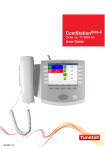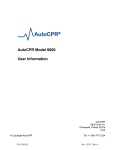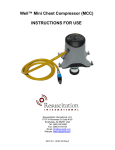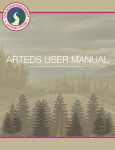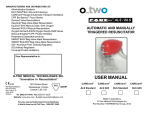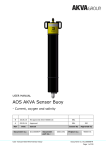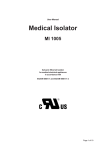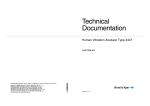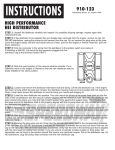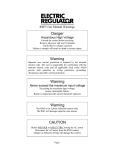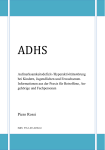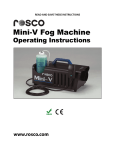Download Emergency Medical Response
Transcript
SUPERIOR FIRE DEPARTMENT Emergency Medical Response SOP 3.3. 1/01/04 EMERGENCY MEDICAL RESPONSE PURPOSE To establish operating procedures and rules governing the operation of Basic Life Support (BLS) or Advanced Life Support (ALS) ambulances within Superior Fire Department. BLS ambulances act as the first tier of a two tiered pre-hospital phase of the Fire and EMS Department’s emergency medical system. It is the foundation on which ALS, the second tier, care is predicated of the pre-hospital phase of the Department’s emergency medical services system. SCOPE This policy will be in effect in all EMS ambulance responses. POLICY Basic Life Support Service To provide the best pre-hospital care possible to any person in need of emergency medical services: 1. There shall be no hesitancy in providing prompt response to every request for emergency service. The stated goal is to have ambulances respond within five minutes of dispatch. 2. The care provided is to be in the best interest of the patient and in accordance with the standard of care applicable to the level of certification of the persons providing care. Response Upon dispatch to an emergency call, the ambulance is to respond to the scene in accordance with the following: 1. Use emergency warning devices, following the procedures outlined in SOP 3.1.1. (Operating Emergency Vehicles). 2. Minimum staffing for an ambulance on an emergency incident shall be two persons. 3. Any person staffing an ambulance on an emergency incident must be: a. An Arizona Department of Health Services (ADHS) certified emergency medical technician, (Basic), or higher. b. The driver of the basic life support ambulance must meet the qualification standards of SOP 3.1.1. (Operating Emergency Vehicles). c. A third or fourth person may ride with the patient as an observer/trainee, provided he/she is certified in cardiopulmonary resuscitation. Emergency Scene Operations 1. Scene Size-Up: SUPERIOR FIRE DEPARTMENT Emergency Medical Response a. Body Substance Isolation (BSI)-Infection control procedures. b. Gloves c. Eye protection d. Gown and mask, if necessary e. Scene safety f. Personal safety: Is it safe to approach the patient? g. Crash/rescue scenes h. Toxic substance; low oxygen areas i. Crime scenes: potential for violence; are police on the scene? j. Unstable surfaces: slope, ice, water k. Protection of the patient-environmental considerations l. Protection of bystanders-Help the bystander avoid becoming a patient SOP 3.3. 1/01/04 m. If the scene is unsafe, make it safe. Otherwise, do not approach or enter. 2. Emergency Scene a. 3. 4. Upon arrival on the scene, the aid person/Officer-in-Charge (OIC) is to ensure that a patient assessment is conducted in accordance with the ADHS Medical Protocols for EMT-Bs or EMT-Ps. Patient(s) should be classified in accordance with the patient triage section of Attachment #1. Patients may only be walked to the ambulance if they do not have a lifethreatening or serious illness or injury, an illness or injury that could be exacerbated by walking and treatment can be maintained during the transfer. Examples of this type of patient include a heart attack or heart disease, respiratory distress, pulmonary edema, respiratory rate < 10 or > 20, heart rate < 60 or > 100, shock like states, and musculo-skeletal injuries. Multiple Casualties-Mass Casualty Incident a. Whenever the Fire and EMS Department responds to an incident in which multiple casualties (eight or more) occur, such as a transportation accident or structural collapse, the first unit on the scene shall notify Fire and EMS Communications as to the number of victims and the extent of the injuries (i. e., minor, severe, fatal), prior to contact with patients. b. Communications will notify the appropriate hospital(s) of the situation in order for the hospital(s) to arrange for the care of victims and put their disaster plan into effect, if necessary. Patient a. Treatment i. The ambulance crew shall perform treatment of injuries and conditions SUPERIOR FIRE DEPARTMENT Emergency Medical Response SOP 3.3. 1/01/04 commensurate with the training level of the ambulance personnel. ii. The “standard of care” shall be the current state EMT-B protocols, where applicable. b. Consent i. When a person is unconscious, or is so ill or badly injured that his judgment is impaired, the law of implied consent shall prevail. If the person does not meet this criteria, he/she cannot be forced to accept treatment or transportation. c. Infectious Disease i. Whenever a patient is patient is known or believed to be suffering from a contagious disease or there is a potential for exposure to blood or body fluids, ambulance personnel will follow the procedures outlined in the Infection Control plan SOP. d. Priority 4 Patients i. When a patient has been classified as “not in need of Fire and EMS Department services” (Priority 4) a medical consultation must be performed to verify that the patient does not need emergency medical treatment. Then the patient shall be advised that their condition does not warrant the use of an emergency ambulance and that they should secure another means of transportation. ii. The OIC shall fully document the assessment and the physical findings on the MAIS runsheet. iii. Reasons for refusing to transport the patient should be clearly indicated in the narrative section of the report. iv. See Section 10. For guidelines regarding handling of deceased victims. e. Refusal of Aid i. A properly documented patient refusal should be obtained when you have offered care to a patient and he/she refuses care (or any aspect of care) or transportation. A patient is defined as an individual on an emergency scene who has a medical complaint, requests medical assistance, and/or has received treatment. ii. Patient refusals are a form of informed consent, and therefore the patient must be capable of making the decision to refuse care. Patients are able to make decisions, if they are: alert and oriented to a person, place, time, events, able to answer to answer questions appropriately, able to understand the consequences of refusing medical care, and not under the influence of minding-altering substances. If the patient is incapable of making an informed refusal, a police officer must be consulted to consider involuntary transport. iii. In the case of patient under eighteen years of age, an attempt must be made to contact the guardian for consent to treatment and transport. Children who are unconscious or with life-threatening injuries or conditions may be treated/transported under the premise of implied consent. The local police department must be contacted if the parent or guardian cannot be located. If the parent or guardian refuses treatment/transport they should sign the appropriate section on the back of the MAIS SUPERIOR FIRE DEPARTMENT Emergency Medical Response SOP 3.3. 1/01/04 runsheet. iv. Refusals do not need to be obtained for calls where the ambulance has been placed in service prior to arrival or arrives on the scene and there are clearly no injuries. However, refusals must be obtained from all involved parties on the scene if anyone on the scene receives care. If a particular individual has no complaints, document this fact on the runsheet and have the patient and the witness sign in the designated areas. When in doubt, err on the side of obtaining the proper refusals. v. When a patient refuses treatment and/or transport, you must advise them of the possible consequences of refusing care (especially if you believe that they are seriously ill or injured) and that they should seek prompt medical attention (including calling us back if necessary) if their condition changes. vi. Proper documentation of a patient refusal of treatment and/or transport on the runsheet includes all of the following: patient assessment, treatment (if applicable), the patient’s level of consciousness/decision-making capability, what you have told him/her about the refusal (as outlined in the previous paragraph), and the patient signature with a third-party witness if possible, (i.e., police officer); the person obtaining the refusal should sign and list their county ID number on the second witness line. Transport 1. Mode of Transportation/Hospital Destination a. All patients should be transported to an appropriate hospital that has the capability of caring for the particular medical emergency of the patient. Not all hospitals have the same responsibilities, i.e., pediatrics, obstetrics, dialysis, etc. Attachment #3 outlines the capabilities of each hospital. i. Priority 1 1. Wherever possible the patient will be transported via Emergency Medical Helicopter. Care must be assumed the Flight Nurse and a signature must be obtained by the responsible individual. Care may not be terminated with out ensuring continuity of care. 2. Transport using emergency warning devices to the nearest hospital/medical facilities having the capabilities and the facilities to stabilize/treat the patient unless otherwise directed by Medical Control or physician on the scene who has assumed medical control. In this instance, the physician MUST accompany the ambulance to the hospital. ii. Priority 2 1. Normally, transport using emergency warning devices to one of the hospitals listed in Attachment #2. At the discretion of the ambulance crew, considering the best interest of the patient, the transport may be accomplished without the use of emergency warning devices. iii. Priority 3 SUPERIOR FIRE DEPARTMENT Emergency Medical Response 1. SOP 3.3. 1/01/04 Transport without the use of emergency warning devices to one of the hospitals listed in Attachment #2; or if requested, (and the patient will not require admission) to a freestanding emergency facility or clinic that is not a greater distance than one of the permissible destination hospitals. iv. Priority 4 1. b. Does not require medical attention. Safety Restraint i. All patients who are transported will be properly restrained in the vehicle. Patients transported on the stretcher will have all three straps securely fastened. Patients transported in the Captains chair or on the bench seat will have a seatbelt securely fastened. Children 40 pounds or less, or under 4 years old, will be secured in a car seat to the stretcher. Patients who are being actively resuscitated may have one or more stretcher straps off to facilitate resuscitation. Family members who accompany patients to the hospital must wear seatbelts while in Fire and EMS Department vehicles. c. Arrival i. Upon arrival at the hospital, all emergency warning devices and the vehicle engine are to be turned off and the ignition keys removed while the vehicle is unattended. d. Admission i. Normally patients are to be delivered to the hospital emergency department; however, some patients (for example obstetrical) may be directly admitted to the appropriate unit of the medical facility, if the patient and the ambulance crew are accompanied by the proper medical staff. ii. Patients are not normally to be allowed to walk from the ambulance into the hospital ED. They may be transported via the stretcher or a wheelchair. All treatments (i.e. oxygen and i.v.s) should be continued during transfer into the ED. iii. Once in the ED the ambulance crew should give a brief report to the receiving nurse. The hospital copy of the run report is to be left with the patient for inclusion in the patient’s records. Where possible a signature should be obtained from the patient on the HIPPA policy form and on the billing sheet. If the patient is unconscious or not responsible for their own care, a responsible party or family member will be allowed to sign for them. A copy of the admitting organization’s “face sheet” listing all of patient’s billing information will be obtained if available and/or a copy of the patient’s insurance information should be made. e. Communications i. Radio Communications 1. Transmission of patients Protected Health Information over the radio shall be avoided in accordance with the Department’s HIPPA Compliance policies. 2. Dispatch shall be notified by all responding personnel whenever: SUPERIOR FIRE DEPARTMENT Emergency Medical Response SOP 3.3. 1/01/04 a. Responding to a call. b. Leaving the station on a call. c. Arriving on scene. d. Requesting more resources. e. Leaving the scene for the hospital. f. Becoming available due to patient refusal or completed transport. ii. Telephone Communications. 1. 2. The ambulance crew should patch with the hospital in any situation where they do not have offline standing orders and require the direction of a higher medical authority. a. The ambulance crew will patch with the hospital in order to document a patient refusal if there are indications that a patient needs immediate medical treatment but is exercising their right of informed consent. b. The crew will patch with the hospital in order to obtain medical direction in order to prioritize the patient’s transport. c. The crew will patch in order to inform the hospital of the incoming patient. 2. The patch should include the information outlined in Attachment #4. 3. The patch should generally take less than one minute. Trauma and Specialty Patients a. All severely injured adult patients in the Town of Superior are to be transported to the Trauma Center at Scottsdale Medical Center and children under 13 are to be transported to Maricopa County Medical Center, unless otherwise directed by Medical Control. i. Level 1 Trauma patients are to be transported via Helicopter. If none is available they may be transported by an ALS Ambulance crew. If no paramedic is available an intercept must be arranged with another agency as per SOP 1.3.5 Mutual Aid. ii. Patients enroute to the Trauma Center, who are in cardiac/respiratory arrest or impending arrest due to the airway obstruction, are to be transported to the closest facility for resuscitation. b. Other facilities that are specially equipped and staffed for certain medical problems are included in Attachment #2. Transportation of patients directly from the scene to one of these facilities should only be done after consultation with Medical Control. c. Patients contaminated by hazardous material are to be treated and transported to the medical SUPERIOR FIRE DEPARTMENT Emergency Medical Response SOP 3.3. 1/01/04 facility that is identified in Attachment #2 as having the capability to handle contaminated patients. The receiving facility must be notified prior to transport. 3. d. Obviously deceased persons are not to be transported. e. Non-emergency and inter-facility patients will not be transported. Hospitals on Reroute Status a. Hospitals have the authority to go on reroute status, whenever their facility/staff does not have the capability to adequately care for any additional patients. i. Regardless of hospital status, Priority 1 Patients are to be delivered to the nearest hospital for evaluation and stabilization. ii. After evaluation and stabilization, the patient may need to be transported to a facility that can continue treatment. b. 4. Priority 2 and 3 patients are to be taken to another permissible destination hospital, unless the hospital on reroute has indicated their ability to care for this specific type of patient. Records a. The hospital copy of the MAIS Runsheet is to be left with the patient in the emergency department for inclusion in the patient’s records. For patients who are to be transported, all pertinent information shall be entered on the MAIS user’s manual. SUPERIOR FIRE DEPARTMENT Emergency Medical Response SOP 3.3. 1/01/04 ATTACHMENT #1 PATIENT ASSESSMENT Initial Assessment 1. Observe and take corrective action for any deficiencies in the patient’s airway, breathing, circulation (pulse), shock. 2. Stop any serious bleeding. 3. Consider implementing C-Spine. 4. Assess/record patient information/vital signs a. General appearance i. Age, sex, and weight ii. General state of health iii. Amount of distress (mild, moderate, severe) b. Objective signs i. Level of consciousness/ Mental Status (A.V.P.U.) ii. Skin: temperature and color iii. Pupil status (reactivity and equality) c. Vital signs i. Pulse: rate, quality, and time taken ii. Respirations: rate, effort, quality, and time taken iii. Blood pressure, note time taken iv. Perfusion: capillary refill time, peripheral pulses, and time taken (for pediatric patients) d. History of episode (obtain from patient/family/observer) i. Chief complaint ii. Time of incident or onset of symptoms and/or prior treatment as related to present illness or injury iii. Mechanism of injury if trauma patient (M.O.I.) 1. Determine from patient, family or bystander what the M.O.I. was, whether insignificant or significant. SUPERIOR FIRE DEPARTMENT Emergency Medical Response SOP 3.3. 1/01/04 iv. Self-treatment and results e. Physical Examination of Trauma and Medical Patients i. Rapid Assessment (High Priority Exam) 1. Significant M.O.I. – Trauma 2. Unstable Medical Patient ii. Focused History Examination (Low Priority Exam) 1. No significant M.O.I. – Trauma 2. Stable Medical Patient (only pertinent with responsive patients). iii. Change patient status from low to high or high to low as it relates to the patient assessment at any point necessary. iv. Perform interventions as needed throughout assessment. v. Consult medical control for direction. vi. Request special/additional personnel/equipment as needed. f. Pertinent Medical History i. Previous medical problems and conditions. ii. Routine medications iii. Allergies iv. Food or fluid intake and activity level (for pediatric patients) Detailed Physical Examination 1. Check for, and take appropriate corrective action for fractures, paralysis, non-profuse bleeding, shock, etc. Patient Triage 1. Identify high-priority patients: a. Poor general impression b. Unresponsive patients (no gag reflex) c. Responsive; not following commands d. Difficulty breathing e. Shock (hypoperfusion) SUPERIOR FIRE DEPARTMENT Emergency Medical Response 2. f. Complicated childbirth g. Chest pain h. Uncontrolled bleeding SOP 3.3. 1/01/04 Priority 1 a. Critically ill or injured person who requires immediate attention. Delay in treatment may be harmful to the patient (potentially threatens life or function). For example: i. Cardiac arrest ii. Suspected acute myocardial infarction iii. Allergic reaction with acute respiratory distress and hypertension (systolic BP less than 80 mm Hg with shock-like signs and symptoms) iv. Burns 1. A patient under 10 or over 50 years old with second and third degree over burns over more than 10% body surface area (BSA). 2. Patients of other ages with second or third degree burns over more than 20% BSA. 3. Second or third degree burns of the face, hand feet, or perineum 4. Electrical burns 5. Chemical burns 6. Respiratory burns v. Respiratory distress 1. Pulmonary edema – with moderate to severe distress 2. Carbon monoxide inhalation 3. Smoke inhalation vi. Overdose/poisoning – unconscious patient o conscious patient with unstable vital signs (pulse less than 60 bpm or more than 120 bpm or hemodynamically significant hypotension) vii. Multiple trauma patient viii. Trauma patient with multiple system involvement and/or any of the following: 1. Clinical shock – systolic blood pressure less than 80 mm Hg. SUPERIOR FIRE DEPARTMENT Emergency Medical Response 2. MAST applied and inflated 3. Respiratory distress 4. Unconsciousness 5. Uncontrollable bleeding SOP 3.3. 1/01/04 ix. Penetrating wound to head, chest, or abdomen x. Severe single system trauma xi. Unconscious, non-trauma patient xii. Seizures 1. Status epilepticus (two or more seizures without a period of complete consciousness), or continuous seizure activity 2. Trauma related seizure xiii. Suspected cardiovascular accident (CVA) with unstable vital signs, decreased level of consciousness (LOC), complicating factors, or progressing signs and symptoms 3. Priority 2 a. Less serious condition, emergency medical attention, but does not immediately endanger the patient’s life. IV’s will be started when indicated, for example; i. Overdose/poisoning – conscious or with stable vital signs ii. Altered mental status in a patient with stable vital signs iii. Congestive heart failure with stable vital signs iv. Burns 1. A patient under 10 or over 50 years old with second or third degree burns over less than 10 % BSA 2. Patients if other ages with second or third degree burns over less than 20 % BSA v. Asthmatics with mild to moderate respiratory distress vi. Mild chest pain – not suspected to be serious in nature vii. Concussions with awakening or agitation viii. Moderate blood loss with stable vital signs, bleeding controlled and no shocklike signs or symptoms SUPERIOR FIRE DEPARTMENT Emergency Medical Response SOP 3.3. 1/01/04 ix. Fractures with neurovascular compromise x. Seizures 4. 1. Multiple separate seizures 2. Seizures associated with signs and symptoms of a CVA Priority 3 a. Non-urgent condition, requires medical attention but not on an “emergency” basis, for example; i. Uncomplicated fractures ii. Minor Burns iii. Lacerations requiring suturing with bleeding controlled. 5. Priority 4 a. Does not require medical attention and may not require transport, e.g. obviously dead. Authorization This Standard Operating Procedure is approved by the Superior Fire Department Chief for implementation. Operations Chief / Fire Marshal Todd Pryor Date 6/1/2008 SUPERIOR FIRE DEPARTMENT Emergency Medical Response SOP 3.3. 1/01/04 ATTACHMENT #2 PERMISSABLE HOSPITAL DESINATIONS Permissible hospital destination include but are not limited to; Priority 1 (Level 1) 1. Scottsdale Memorial 2. Good Samaritan 3. Scottsdale Osborn 4. Maricopa County 5. Saint Joseph Priority 2 (Level 2) 1. Banner Baywood Medical Center Priority 3 (Level 3) 1. Cobra Valley Priority 4 (Level 4) 1. No transport SUPERIOR FIRE DEPARTMENT Emergency Medical Response SOP 3.3. 1/01/04 ATTACHMENT #3 PATCH GUIDE Patch Guide This is (Name, Unit), with Superior Fire Department, (On-scene/In-route) with a ( Age, ??Sex, LOC). Vitals (BP, Pulse, Resp, EKG) C/C Brief MOI Assessment (Brief and Significant) Past HX (Pertinent to Event) Treatment ETA to Receiving Facility Type of Patch (Refusal, Courtesy Notification, Requesting Orders) Patch should be brief, 1 min or less.



















